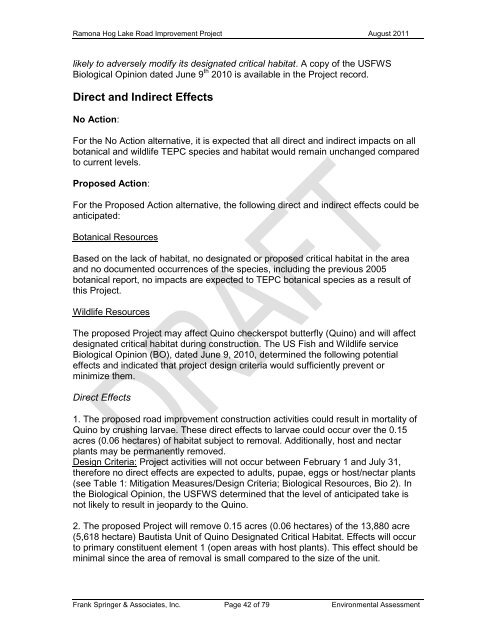environmental assessment for the hog lake road improvement project
environmental assessment for the hog lake road improvement project
environmental assessment for the hog lake road improvement project
Create successful ePaper yourself
Turn your PDF publications into a flip-book with our unique Google optimized e-Paper software.
Ramona Hog Lake Road Improvement Project August 2011<br />
likely to adversely modify its designated critical habitat. A copy of <strong>the</strong> USFWS<br />
Biological Opinion dated June 9 th 2010 is available in <strong>the</strong> Project record.<br />
Direct and Indirect Effects<br />
No Action:<br />
For <strong>the</strong> No Action alternative, it is expected that all direct and indirect impacts on all<br />
botanical and wildlife TEPC species and habitat would remain unchanged compared<br />
to current levels.<br />
Proposed Action:<br />
For <strong>the</strong> Proposed Action alternative, <strong>the</strong> following direct and indirect effects could be<br />
anticipated:<br />
Botanical Resources<br />
Based on <strong>the</strong> lack of habitat, no designated or proposed critical habitat in <strong>the</strong> area<br />
and no documented occurrences of <strong>the</strong> species, including <strong>the</strong> previous 2005<br />
botanical report, no impacts are expected to TEPC botanical species as a result of<br />
this Project.<br />
Wildlife Resources<br />
The proposed Project may affect Quino checkerspot butterfly (Quino) and will affect<br />
designated critical habitat during construction. The US Fish and Wildlife service<br />
Biological Opinion (BO), dated June 9, 2010, determined <strong>the</strong> following potential<br />
effects and indicated that <strong>project</strong> design criteria would sufficiently prevent or<br />
minimize <strong>the</strong>m.<br />
Direct Effects<br />
1. The proposed <strong>road</strong> <strong>improvement</strong> construction activities could result in mortality of<br />
Quino by crushing larvae. These direct effects to larvae could occur over <strong>the</strong> 0.15<br />
acres (0.06 hectares) of habitat subject to removal. Additionally, host and nectar<br />
plants may be permanently removed.<br />
Design Criteria: Project activities will not occur between February 1 and July 31,<br />
<strong>the</strong>re<strong>for</strong>e no direct effects are expected to adults, pupae, eggs or host/nectar plants<br />
(see Table 1: Mitigation Measures/Design Criteria; Biological Resources, Bio 2). In<br />
<strong>the</strong> Biological Opinion, <strong>the</strong> USFWS determined that <strong>the</strong> level of anticipated take is<br />
not likely to result in jeopardy to <strong>the</strong> Quino.<br />
2. The proposed Project will remove 0.15 acres (0.06 hectares) of <strong>the</strong> 13,880 acre<br />
(5,618 hectare) Bautista Unit of Quino Designated Critical Habitat. Effects will occur<br />
to primary constituent element 1 (open areas with host plants). This effect should be<br />
minimal since <strong>the</strong> area of removal is small compared to <strong>the</strong> size of <strong>the</strong> unit.<br />
Frank Springer & Associates, Inc. Page 42 of 79 Environmental Assessment
















